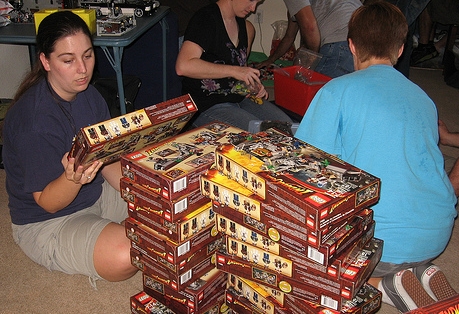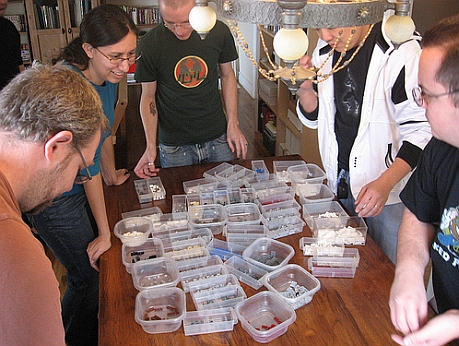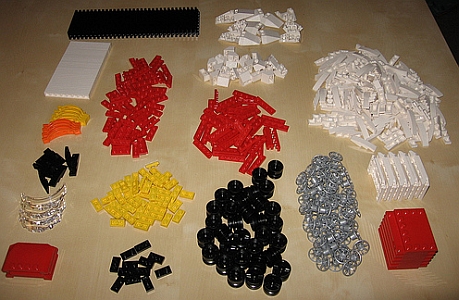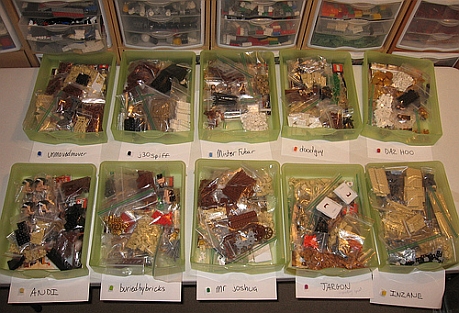(Written by William)
We’re not driving behind a big-rig or playing fantasy sports, we’re talking LEGO drafting. Many new LEGO Users Groups (LUGs) may not have any idea what to do when they get together. Sure you can plan to participate in an exhibit or combine your resources to create something that one person would not be able to do alone, but what else is there?
In this article will talk about one possible activity that any LUG can do, no matter what the size, and that’s LEGO drafting. Just keep in mind, the prep work that goes into this activity may put some people off.

➡ WHAT IS LEGO DRAFTING & WHAT IS THE PURPOSE?
LEGO drafting is when a group of people get together and part out a LEGO set amongst the members. The process can be done with any LEGO set and quantity of sets. The idea is that each person wants more LEGO elements of a certain type, but they want to avoid purchasing twenty copies of a single LEGO set to get them.

➡ HOW DOES LEGO DRAFTING WORK?
First determine who wants to participate. Then set a price for the draft. Usually, this price involves the price of the LEGO sets divided by the participants. Before you begin drafting, decide how you want to split up the pieces. Once lots are drawn up, set a turn order for those people who are drafting. When all the lots are picked, the draft is done.
➡ ORGANIZING LEGO LOTS
The group should decide how a set is divided. You can choose color of an element, function of an element, monetary value of an element, or all unique elements. Make sure to stay flexible in the group regarding this method. You most likely will need to change how lots are divided because of conflicting interests.
A good example is the minifigures in the set. They are usually what costs the most in any given set and may cause problems if they’re bunched up. A good way to address this is to assemble the legs, torso, and head then set each minifigure as its own lot.

➡ RESULTS OF A LEGO DRAFT
By the time the draft ends you should have pieces that roughly equal the price you paid. For example, let’s say ten people split up two sets that cost $50 each. Your buy-in would have been $10. You should walk away with $10 of pieces. Another example would be if everyone bought a $20 set for the draft. Then you should walk away with roughly $20 worth of parts.

➡ SUMMARY
The draft may get slightly competitive at times depending on the pieces available. However, much of the stress can be eliminated if people talk about problems they see ahead of time. LEGO drafting is a great social activity that not only scores you LEGO pieces you want, but gives people topics to discuss. Perhaps you may guess what someone plans to build based on the parts they’re going for. Whatever the case, drafting is something every LUG should try at least try once. It’s fun! 🙂
Here are some other tips for LEGO Users Groups you might like:












Yes, drafting is great! It is one of the best ways to get the parts you want! You don’t even have to be a lug member. If you just have some friends who like lego and you guys agree on what to buy together and part out, even a few people can do it together.
Also, I have seen some online drafts. I think FBTB has them at times. FBTB buy like 10 of the same set, then people can register who want to be part of the draft, they pay, and the drafting is done live via Skype. Then they receive the parts they got by mail.
I like local drafting more as I can get my parts right away, but online drafting can be fun too! 🙂
I agree with the local draft. There’s something satisfy about drafting and walking away with what you picked.
It also helps to have not only friends who like LEGO, but friends who have a like-minded interest in general building elements. My own LUG’s first draft had a little trouble getting started simply because people disagreed on the set they wanted to draft. Although diversity is good since many people won’t walk away with the same type of elements. Overall, it was extremely enjoyable.
Thanks for reading and commenting!
Yes, I agree, drafting is a great way to get the parts you want and it is also a fun activity. Just to clarify; in your second example you mention that if everyone brought in a $20 set for the draft, they should walk away with roughtly $20 worth of parts at the end. Are you suggesting here that drafts don’t necessarily have to include all the same sets?
Of course participants can decide hoewere they want to do a draft, but I’m just wondering how easy and fair would be to run a draft where everyone brought in totally different sets. (Like for example Star Wars and castle). I can imagine a draft like that turning into a nightmare/
One reason I like drafts is that I can get a good amount of the same parts. Something that is easy to do when the sets in the draft are all the same. I just haven’t thought of a draft where different sets would be used. It almost sounds like a swap then, not a draft.
Just wondering what is your experience with this.
I was talking about having the same set. Our LUG had to stop quibbles about parts and the way we did that is to use Bricklink prices to generate lots of that were roughly equivalent monetarily.
Mainly because the whole principle of the draft is to get a lot of the same element and that only works with the same set.
Currently, our group is discussing doing a parts swap. And hopefully in a future blog I’ll be able to go over the process on how we did and whether or not it was a successful activity.
Thanks for reading and commenting. I hope that answered your questions.
Great post, Will! Thanks! I would just like to add that drafting is also a great activity for kids. It has to be supervised by an adult, but we do it in our neighborhood where many kids (and parents) are into lego.
Yeah, that’s one of the reasons why our group decided to pursue it as an activity. We have an emphasis on everyone in the family being able to participate and drafting was one of the options where we found young and old could participate.
Thanks for commenting!
Thanks for you blog, very interesting details.
You wrote: if everyone bought a $20 set for the draft. Then you should walk away with roughly $20 worth of parts.
Is the difference really roughly ? Some pieces have the double price of others and when no splitting is done I can imagine that the difference can be consequent.
Usually the players take care of the end value what they get ?
Thanks for you work !
The reason why its roughly is because for the most part, the only value monetarily for pieces can be found on bricklink. However, the needs of the builder could have a much higher value on particular pieces. It roughly balances out since one person who wants a rare element may forgo a minifigure and someone who wants a sticker sheet may get one instead of either of those two, and so on. Plus, trading is encouraged after the draft, just to make sure people get what they want.
Ideally, the best drafts come when everyone who’s drafting can get a set on sale. That way people may still be paying $20, but each person is bringing a $40 set that was 50% off. This is the general rule of thumb that my LUG uses when pursuing a set to draft.
Going back to your original question, we do take one more step to encourage equivalency in the value of parts. Whoever is dividing up the lots will try to make each lot equal in price value to every other lot. This may mean that a super rare element may be broken into multiple lots and/or minifigures may appear as individual lots. However, it will all depend on the group that is drafting, who determines what is fair. I just know that there is a little less conflict when you can make the monetary value of the lots as equal as possible.
Thanks for your comment!